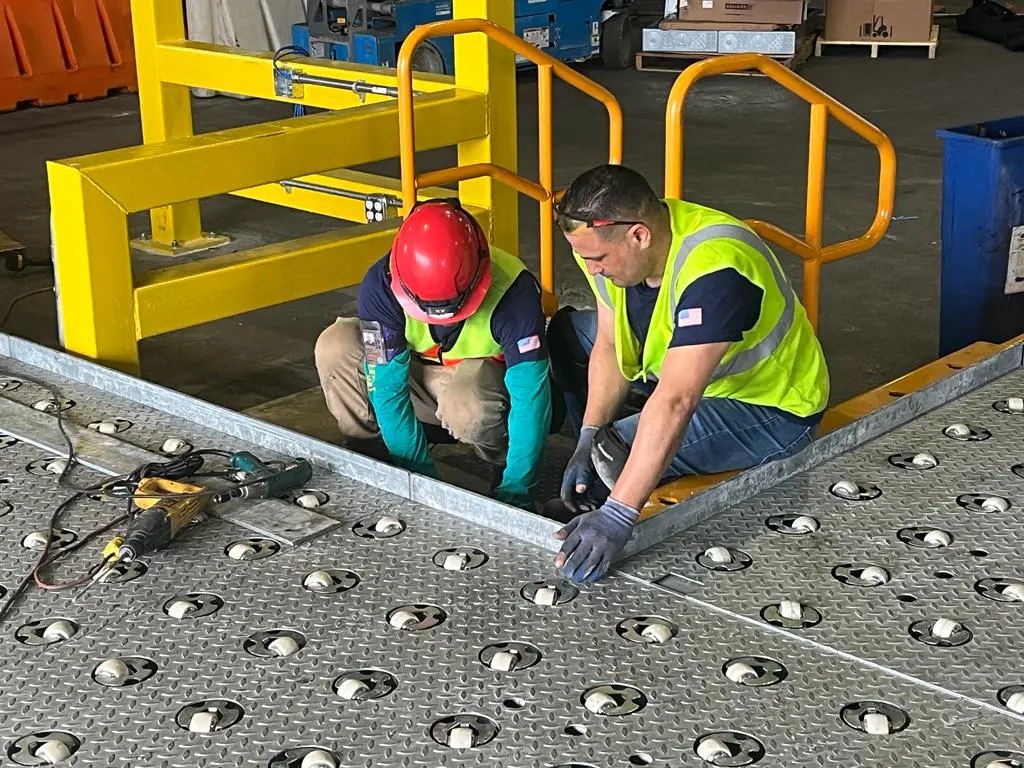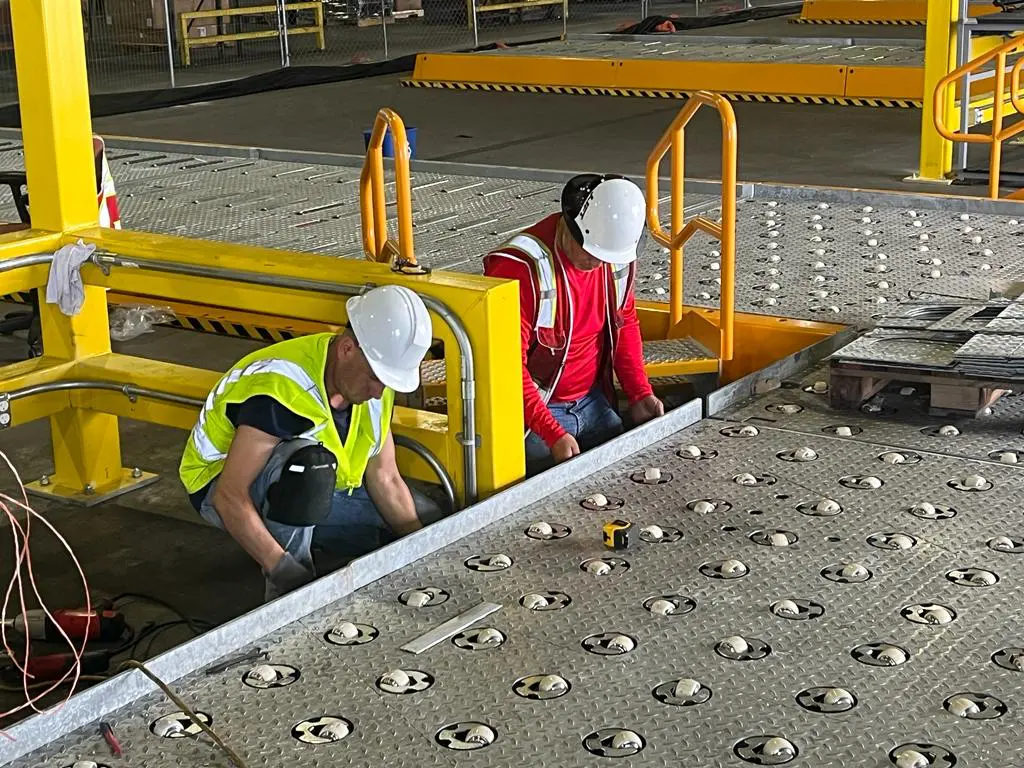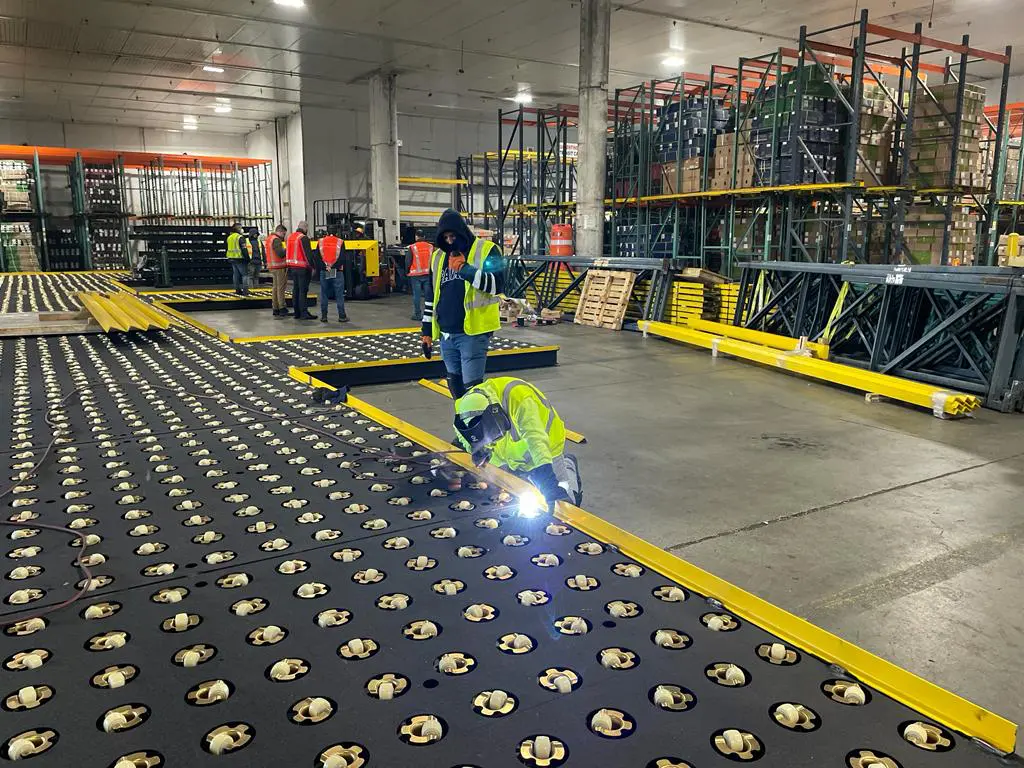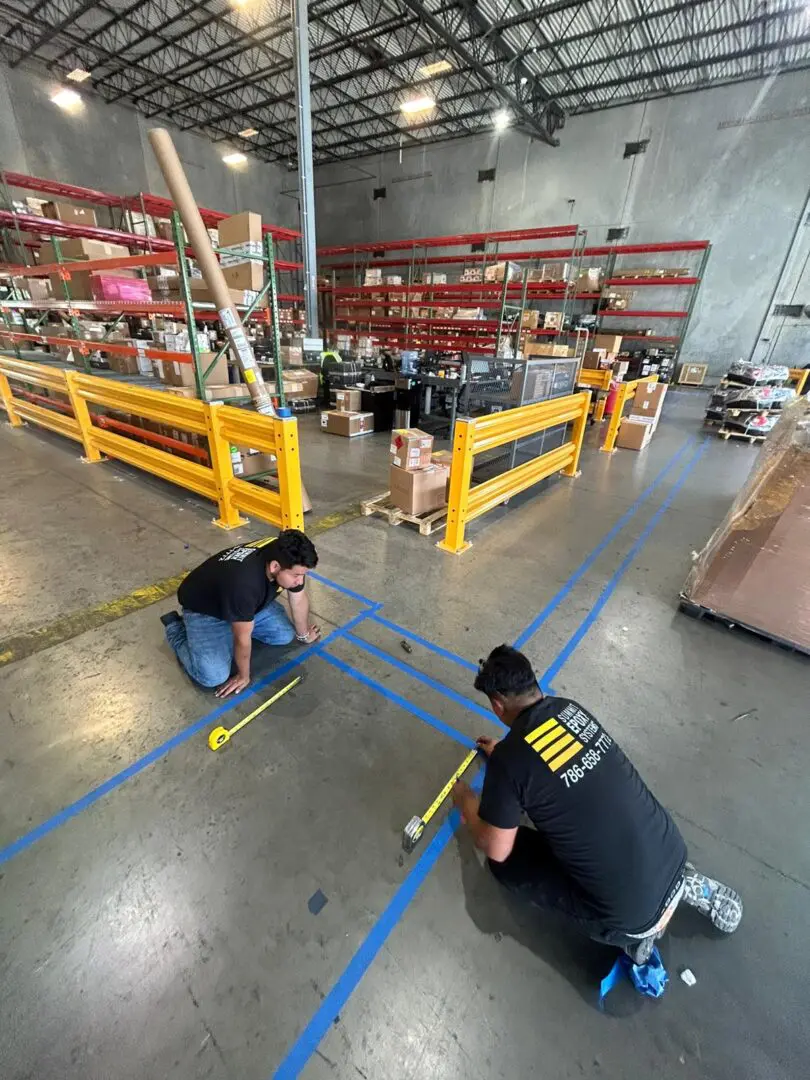Warehouse Maintance & Repair
Warehouse Signage & Rack labeling
Warehouse signage and rack labels are essential components of efficient warehouse management systems. They provide visual cues and information to warehouse personnel, helping them navigate the warehouse, locate items, and manage inventory effectively. Here's an overview of warehouse signage and rack labels, including their types, functions, and benefits:

Warehouse Signage:
- Location Identification: Signage is used to identify specific areas within the warehouse, such as aisles, zones, or departments. This helps personnel navigate the warehouse efficiently and locate items quickly.
- Safety Signage: Signage is used to communicate safety information and warnings, such as "Caution: Forklift Traffic" or "Emergency Exit." This helps ensure a safe working environment for warehouse personnel.
- Directional Signage: Signage is used to provide directional guidance, indicating the flow of traffic, designated pathways, or the location of important facilities such as restrooms or break rooms.
- Informational Signage: Signage is used to provide additional information, such as operating procedures, emergency protocols, or inventory management instructions.
- Visual Management: Signage is used as part of visual management systems to communicate key performance indicators (KPIs), inventory levels, or other relevant metrics to warehouse personnel.
Rack Labels:
- Location Identification: Rack labels are used to identify specific locations within the warehouse, such as shelves, bins, or pallet positions. This helps personnel locate items accurately and efficiently.
- Inventory Management: Rack labels are used to manage inventory by providing information such as SKU numbers, product descriptions, lot numbers, or expiration dates. This facilitates accurate inventory tracking and replenishment.
- Barcode Scanning: Rack labels often include barcodes or QR codes that can be scanned using handheld devices or barcode scanners. This allows for quick and accurate data capture during inventory management processes.
- Organization and Efficiency: Rack labels help organize warehouse space by clearly delineating storage locations and optimizing storage density. This improves efficiency by reducing search times and minimizing picking errors.
- Customization: Rack labels can be customized to suit specific warehouse requirements, such as label size, format, or material. This allows for flexibility in labeling different types of racks or storage systems.
Benefits:
- Improved Efficiency: Warehouse signage and rack labels streamline warehouse operations by providing clear guidance and information to personnel, reducing search times and improving productivity.
- Accuracy: By accurately identifying locations and inventory items, signage and rack labels help minimize errors in picking, packing, and inventory management processes.
- Safety: Signage communicates safety information and warnings to warehouse personnel, reducing the risk of accidents and injuries in the workplace.
- Organization: Signage and rack labels help organize warehouse space and optimize storage density, maximizing the use of available storage capacity and facilitating efficient inventory management.
- Visibility: Bright, visually appealing signage and clear, legible rack labels enhance visibility in the warehouse, making it easier for personnel to locate items and navigate the facility.

Types:
- Aisle Signs: Mounted above aisles to identify aisle numbers or names, helping personnel navigate the warehouse.
- Directional Signs: Provide directional guidance, indicating the location of specific zones, facilities, or landmarks within the warehouse.
- Safety Signs: Communicate safety information and warnings, such as hazard warnings, fire exit signs, or personal protective equipment (PPE) requirements.
- Rack Labels: Attached to racks or shelves to identify storage locations and provide inventory information, such as SKU numbers, descriptions, or barcodes.
- Floor Markings: Used to designate pedestrian walkways, forklift lanes, or storage areas, enhancing safety and organization in the warehouse.
In summary, warehouse signage and rack labels play a critical role in efficient warehouse management by providing visual cues and information to personnel, facilitating navigation, inventory management, and safety in the warehouse environment.
A warehouse security enclosure is a physical barrier or structure designed to enhance security and control access to specific areas within a warehouse or distribution center. These enclosures are typically constructed using various materials such as steel, wire mesh, or chain-link fencing and are installed to create secure zones within the warehouse environment. Here are some key features and functions of warehouse security enclosures:
Key Features:
- Perimeter Protection: Security enclosures are installed around designated areas within the warehouse, such as storage areas, high-value goods, equipment, or restricted zones, to create a secure perimeter.
- Access Control: Enclosures may include gates, doors, or entry points equipped with locks, access control systems, or keypad entry to restrict access to authorized personnel only.
- Visibility: Many security enclosures are constructed using wire mesh or chain-link fencing, allowing for visibility into and out of the enclosed area. This visibility enables security personnel to monitor activities and detect unauthorized access.
- Deterrent to Theft and Vandalism: The presence of security enclosures acts as a deterrent to theft, vandalism, and unauthorized entry by making it more difficult for intruders to access valuable assets or inventory.
- Customization: Security enclosures can be customized to fit the specific needs and requirements of the warehouse, including size, shape, height, and configuration to accommodate various layouts and operational needs.
- Scalability: Security enclosures can be scaled or expanded as needed to accommodate changes in warehouse operations, layout, or security requirements over time.
Functions:
- Asset Protection: Security enclosures help protect valuable assets, inventory, equipment, and materials stored within the warehouse from theft, damage, or unauthorized access.
- Inventory Control: By restricting access to designated storage areas, security enclosures enable better control and management of inventory, reducing the risk of shrinkage, loss, or pilferage.
- Safety and Compliance: Enclosures may be used to secure hazardous materials, equipment, or areas requiring special safety protocols or regulatory compliance, such as flammable liquids, chemicals, or restricted access zones.
- Workplace Security: Security enclosures contribute to overall workplace security by preventing unauthorized individuals from entering sensitive areas, reducing the risk of workplace violence, theft, or unauthorized activities.
- Access Management: Enclosures allow for controlled access to designated areas, enabling businesses to monitor and track personnel movements, deliveries, and visitors entering and exiting the warehouse.
- Liability Reduction: By implementing security enclosures, businesses can mitigate liability risks associated with theft, property damage, accidents, or unauthorized access incidents within the warehouse.

Applications:
- Inventory Storage: Securing high-value inventory, sensitive materials, or goods requiring special handling or storage conditions within the warehouse.
- Equipment Storage: Protecting valuable equipment, machinery, tools, or vehicles stored on-site from theft, vandalism, or unauthorized use.
- Restricted Access Zones: Creating secure zones for restricted access areas such as server rooms, IT infrastructure, hazardous materials storage, or confidential documents.
- Loading Docks: Securing loading docks and receiving areas to prevent theft, tampering, or unauthorized access to incoming and outgoing shipments.
- Employee Areas: Creating secure break rooms, locker rooms, or employee-only zones within the warehouse to enhance employee safety and privacy.
In summary, warehouse security enclosures play a crucial role in enhancing security, controlling access, and protecting assets within warehouse and distribution center environments. By implementing these physical barriers, businesses can improve inventory control, reduce theft and vandalism, enhance workplace safety, and ensure compliance with regulatory requirements.
Warehouse Maintenance:
Rolling / Overhead Doors Repair:
- Roll-Up Doors: Inspection and repair of roll-up doors used for loading docks, entrances, and exits to ensure smooth operation, proper sealing, and security.
- Sectional Doors: Maintenance and repair of sectional overhead doors used for warehouse entrances, vehicle access, and security, addressing issues such as damaged panels, springs, and tracks.
- High-Speed Doors: Service and repair of high-speed doors designed for rapid opening and closing, minimizing air infiltration, temperature loss, and energy consumption in the warehouse.
- Dock Doors: Repair of dock doors and levelers used for loading and unloading trucks, addressing issues such as damaged seals, hinges, tracks, and hydraulic systems.
- Fire Doors: Inspection and repair of fire-rated doors and shutters to ensure compliance with fire safety regulations and protect personnel and property in the event of a fire.

Dock Leveler Maintenance & Repair:
- Hydraulic Systems: Inspection, lubrication, and maintenance of hydraulic dock levelers to ensure smooth operation, proper alignment, and safety during loading and unloading operations.
- Mechanical Components: Service and repair of mechanical dock levelers, including hinges, springs, locks, and lip controls, to maintain functionality and prevent accidents.
- Safety Features: Testing and calibration of safety features such as safety lips, edge barriers, and interlocks to ensure compliance with safety standards and protect workers from injury.
- Pit Cleaning: Regular cleaning and inspection of dock leveler pits to remove debris, grease, and dirt that can impede operation and cause damage to equipment.
- Emergency Repairs: Prompt response to emergency repair requests for dock levelers to minimize downtime, restore functionality, and maintain productivity in the warehouse.
Benefits:
- Safety: Regular maintenance and repair of warehouse facilities, doors, and dock levelers enhance safety for workers, visitors, and equipment operators, reducing the risk of accidents and injuries.
- Reliability: Proper maintenance ensures the reliable operation of warehouse equipment and facilities, minimizing downtime, disruptions, and delays in operations.
- Cost Savings: Proactive maintenance and timely repairs prevent costly breakdowns, damage, and replacements, saving money on repair expenses and lost productivity.
- Compliance: Maintenance activities ensure compliance with safety regulations, building codes, and industry standards, reducing the risk of penalties, fines, and liability issues.
- Efficiency: Well-maintained facilities, doors, and dock levelers optimize workflow efficiency, productivity, and throughput in the warehouse, maximizing operational performance and profitability.
In summary, warehouse maintenance, door repair, and dock leveler maintenance are essential components of facility management in warehouse and distribution center operations, ensuring safety, reliability, and efficiency in the handling and storage of goods. Regular maintenance and timely repairs contribute to the longevity and functionality of warehouse facilities and equipment, supporting operational success and customer satisfaction.

